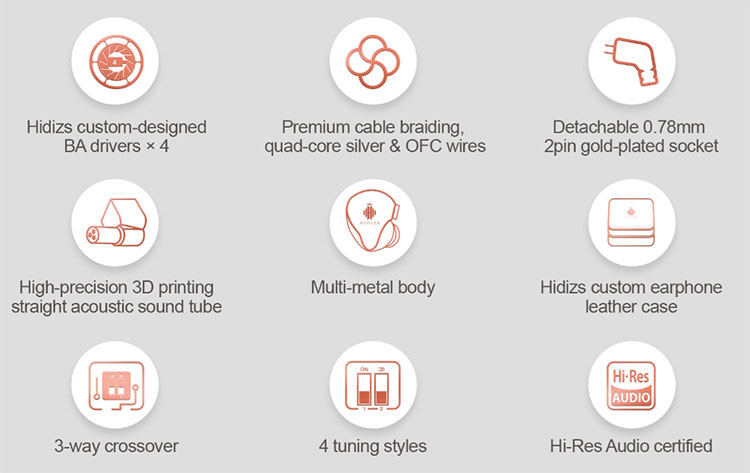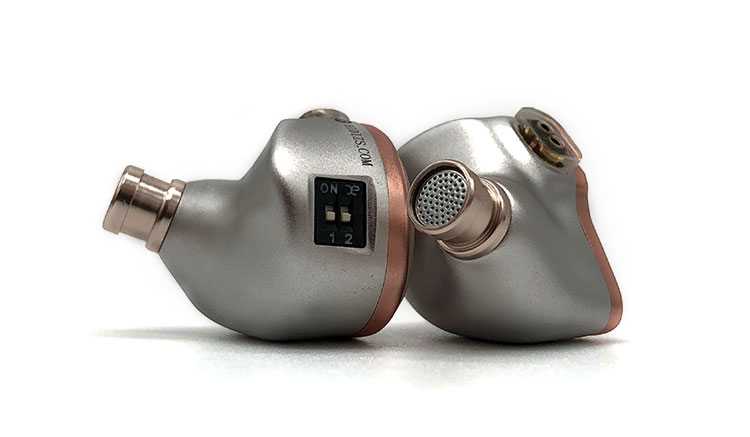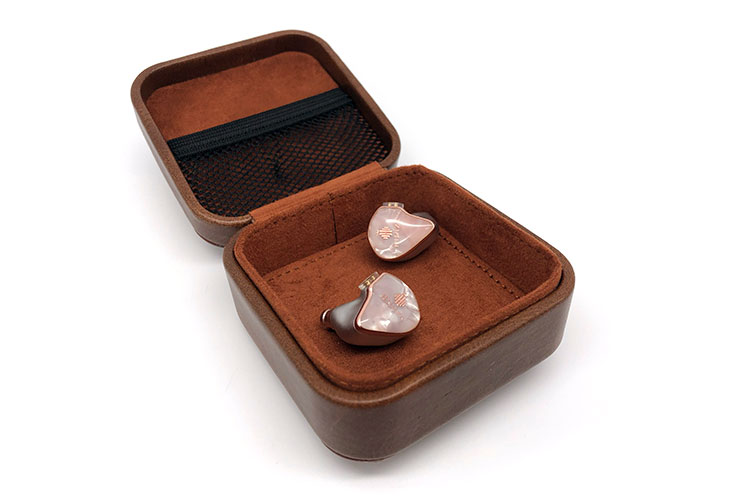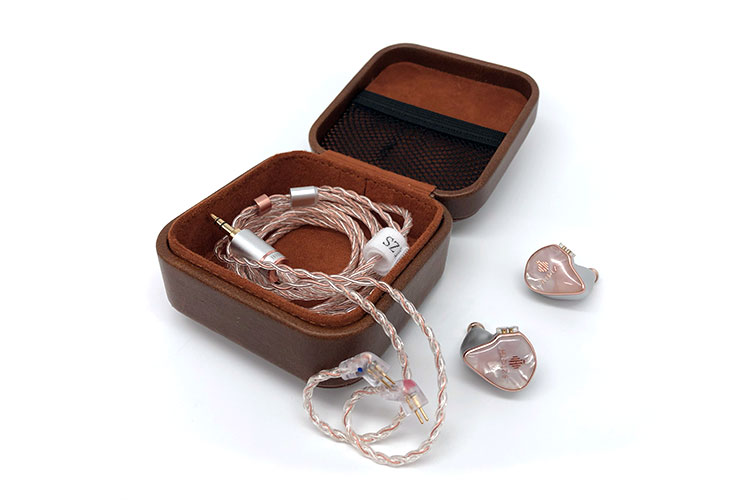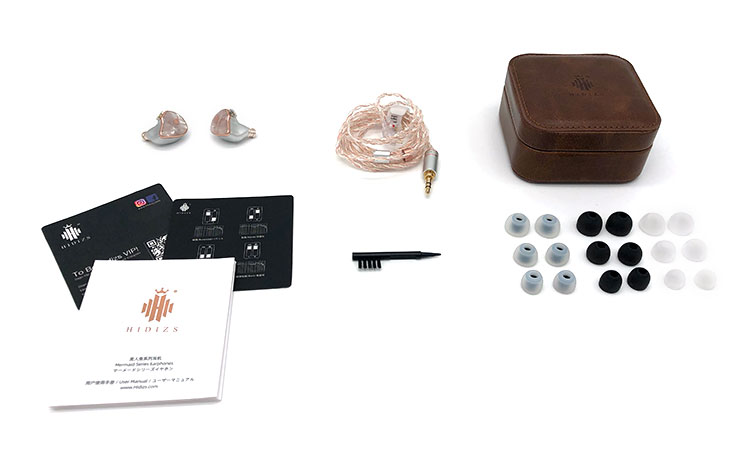This is a review of the new Hidizs MD4 which is a universal four BA driver IEM featuring a dip-switch system offering up to 4 unique tuning profiles. It is currently priced at $179.
Disclaimer: This sample was sent to us in exchange for our honest opinion. Headfonics is an independent website with no affiliate links or status. We thank Hidizs for this opportunity.
To read more about Hidizs products we have previously covered on Headfonics click here.
Note, that this article follows our latest scoring guidelines which you can read up on here.
To date, all my Hidizs IEM reviews such as the MM2 have offered a mix of drivers such as magnetostatic and dynamic instead of the balanced armatures they typically use in their earlier releases like the MS4. Both IEM hybrid designs use a 10.2mm dynamic driver.
Well, Hidizs has decided to add a new Mermaid Series IEM called the MD4. With no dynamic driver in sight, this is a BA-only implementation with an easily customizable sound profiles system built into the shells.
You can consider the MD4 the BA equivalent of the hybrid MS4 in terms of product position with both being Hidizs’s most complex IEMs to date and their respective co-flagship offerings despite still being relatively affordable at $179 each.
Tech Highlights
The MD4 is an all-BA universal IEM featuring a quad driver implementation. The precise grouping is one driver each allocated for mids and treble with the final two BAs running point to keep the bass tight and rich.
More drivers the better right? Well, that depends on how well each one handles their forte separately and also jointly combining into a well-choreographed performance.
The MD4 tackles this using a 3D printed straight acoustic sound tube to reduce overlap and interference as well as a 3-way crossover.
Of course, we can’t wrap up this section without talking about the tuning switches found in each earpiece. Four sound profiles in a single IEM with choices of balanced, warm, treble, and bass.
Two toggle switches can be flipped up or down and depending on the combination there is an assigned change in frequency response. And since the switches control the BA drivers directly and do not rely on filters, there is a greater effect with altering the sound.
Design
Th HIdizs MD4 comes in three color options, black, indigo, and white with this sample being their white finish.
The aesthetics have an amber-like celluloid faceplate infused with gold ornamentation shaped to the company logo of Hidizs and fully coated in resin for enhanced protection. In white, this centerpiece of the MD4 attracts with its simple elegance versus the quaint indigo version or the stealthy sophistication of black.
Sandwiched between the faceplate and the aluminum alloy main body of the MD4 is a rose gold middle frame reminiscent of the Hidizs MS4. Its light hue and subdued glisten provide a seamless and cohesive transition between the contrasting materials.
There is no color coding to signify which side is left or right aside from a small label around the top of the MD4 near the switches. Speaking off, the two switches used for changing the tuning is accessible and flush so a thin tool to flip settings is needed, or simply use the flat end of the cleaning brush.
Comfort & Isolation
The MD4 uses an angled 2-pin connector system that helps a lot in keeping the MD4 in place as the nozzle and tip length combination I used is a bit longer than preferred.
So even though the seal is not an issue, fitment in my experience is a give and take as I had to use the small pair of balanced tips and still had to be careful not to move too much.
With the MD4 finally settling in comfortably, I was able to get a nice amount of passive isolation from background noise with a muffled pickup of voices and bustling city streets.
Tips
There are three ear tip varieties readily available with the MD4 and each has a particular focus on a balanced sound signature, vocal, or bass-focused profile.
The balanced ear tips are the only ones out of the three tip options that use a combination of materials having a stiff black stem that transitions into a bluish halo onto a transparent and soft flange.
The transition of material however results in a firm opening that can put pressure on the ear canal if fitted improperly.
With the bass tips, it is the tallest of the three options, and having a softer stem makes it quite pliant as well putting it closer to the average tips found in other IEMs.
Taking a look at the ones marked for vocal, the most obvious difference aside from its white color is the wider bore diameter it has supplemented by also being the shortest of the bunch.
Stock Cable
Complementing the clean sheen of the aluminum shell and white faceplate, the four-core cable braided in a twisting pattern is built with transparent sleeving for a see-through effect showcasing the mixed-use of silver and copper wires.
Kept in a portable length of 1.2m, it is pretty supple and won’t get in the way having almost no memory retention. But compared with other IEM cables in my possession, it has a thinner than average construction.
What’s subtly elevating its overall appearance is Hidizs’ use of rose gold inserts in the 3.5mm jack and the y-split making the cable provided an ideal match to the MD4’s gold features.
Packaging & Accessories
Packed in a cubic black box trimmed with gold texts, unboxing the MD4 is upscale, free from heavy graphics or animations used by other mainstream competitors. What’s left in focus is a 3D render of the black variation of the MD4 even though what I received inside is the white one.
Using the pull-tab to free the first layer holding the IEM will reveal the accessories beneath starting with a cleaning tool alongside three sets of ear tips for different sound profiles with three pairs each for size. The balanced tips are already attached to the MD4’s nozzle ready for use.
A third layer beneath is for the rustic-looking faux-leather case that is stitched and nicely padded making use of magnets holding it shut. The detachable braided cable will finally be found inside.
Sound Impressions
The balanced ear tips and sound profile were used in the formulation of the sound impressions. How the sound is changed by swapping tips and tuning styles will be discussed separately.
Summary
With two drivers tackling the bass frequencies, it comes as no surprise that the MD4 is not the most neutral IEM around. But if there’s anything I wasn’t expecting, is for the MD4’s sub-bass to roll off as fast.
The midrange in its default setting may also appear shy to some users, but there’s no need to fret since the effects of the tuning switches will be described in a later section.
Hidizs did a great job with their crossover application on the MD4 which justifies their years of experience with their earlier BA-based monitors. Listening in, there wasn’t a time that I thought I’m listening to any specific driver so it does sound very coherent.
Timbre
Even with a tandem of low-end frequency BA drivers, the MD4 wasn’t able to hide that lack of dynamics driver slam. I’m not saying this as a negative though since the warmth of its bass has a nice backbone for a controlled and tight picture.
Even though the vocal region is not life-sized by a long stretch, its best quality is with the center imaging and the bite of textures that simulate an expansive soundscape allowing objects to breathe.
Listening to a chorus is enjoyable and not shouty, only sidetracked sometimes brought by the recessed midrange energy shifting the focus to the bass region.
If there’s a minor quirk that I’ve noticed with the tonality of the MD4 is with certain female singers that I usually listen to. Towards the low-mids, there is a bit of a nasal character developing.
Quieter details are pulled up with piano and strings which is especially perceptible when listening to acoustic tracks. Guitars are more shimmery on the edges than expected but have a body that is ready to support.
Though not too hot and fatiguing, the treble presence is a toss-up as I find some instruments varying in vigor. Cymbals for example get slightly muted from busier passages, while electric guitars can be much easier to find.
Percussive instruments and chimes are crisp and resolving. Sound-wise, it is tilted towards heft and muscle than natural.
Staging
The MD4 creates a more expansive lateral stage than it is deep. And with a height that is just tall enough to give dynamic instruments room puts more emphasis on its capability to image properly.
Immersing into an outdoor live recording will make use of the wide soundscape, and placement can be expected to pinpoint the audience with great separation and differentiation from one another.
Where the MD4 struggles with is the imaging between the outermost and center image as drum rolls lose energy when panning.
Ear Tips
Switching from the balanced tips to the ones marked for vocals brought the center image closer making it peppier and engaging. It gave singers room to shine and play more with the bass while also putting more heft with the strumming of the guitar.
Unsurprisingly, the bass tips put more emphasis on the mid-bass and lifted with it its neighbor for a more solid thump. This however widens the gap with the vocal region and shaves off the shimmer with strings.
Tuning Switches
I thoroughly enjoyed switching between the sound modes although at the beginning I encountered a channel imbalance issue where the center image is slightly shifted towards the left.
Using mono sound to make sure both earpieces receive the same signal and tinkering with the switches revealed that the left IEM’s out-of-the-box switch settings were mismatched
Coming out of the balanced setting, the warm tuning boosted not just the mids but also the bass presence. And as the name suggests, its more inviting midrange is now more confident and staged closer while also tipping the treble timbre to be closer to the expected metallic splash of cymbals.
Toggling the switches to be tuned for bass, the low-end is now even more pronounced extending its effect to the lower mids which on specific passages could use some dialing down.
This setting does make good use of the two BA installed for bass presence as pops and beats are livelier.
The treble switch setting didn’t spike up the treble as expected, instead, it adjusted the tonality to be thinner and worked on improvements in extension and air. In this setting, the MD4 sounded more like a V-shaped IEM with the pulled-back midrange energy making it quite hard to seem enticing, even with soulful singers.



